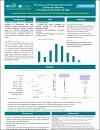Prevalence and Potential Determinants of Insomnia Disorder in the General Population of Qatar
| المؤلف | Khaled, Salma Mawfek |
| المؤلف | Petcu, Catalina Gabriela |
| المؤلف | Al-Thani, Maryam Ali |
| المؤلف | Al-Hamadi, Aisha Mohammed |
| المؤلف | Woodruff, Peter |
| تاريخ الإتاحة | 2020-10-26T08:49:52Z |
| تاريخ النشر | 2020 |
| اسم المنشور | Qatar University Annual Research an Exhibition 2020 (quarfe) |
| الاقتباس | Khaled S.M., Petcu C.G., AlThani M.A., AlHamadi A.M., Woodruff P., " Prevalence and Potential Determinants of Insomnia Disorder in the General Population of Qatar", Qatar University Annual Research Forum and Exhibition (QUARFE 2020), Doha, 2020, https://doi.org/10.29117/quarfe.2020.0130 |
| الملخص | Aims: To estimate the prevalence of Insomnia Disorder in the household population of Qatar and explore potential associations with depressive and anxiety symptoms in addition to sociodemographic variables. Methods: Probability-based sampling was used to select a representative sample (N= 1,611) of Qatar's household population. Face-to-face household interviews were conducted by trained staff using computer-assisted technology with consenting participants who were 18 years or older living in Qatar by the Social and Economic Research Institute (SESRI) at Qatar University as part of the Annual Omnibus survey in February/ March, 2019. The Sleep Condition Indicator (Epsie, 2014), a brief screening tool for DSM-5 criteria, was used to estimate the prevalence of insomnia in Qatar's general population. Depressive and anxiety symptoms were ascertained using the PHQ-9 and GAD-2. Sociodemographic and health information including personal and family history of autoimmune disease were also collected. Univariate, bivariate, and multivariate statistics were conducted. Results: The prevalence of insomnia was 5.5% (95%CI: 4.3-6.7) and was higher in females (6.3%) than males (4.6%), though these differences were not statistically significant (P = 0.216). Insomnia was strongly associated with depressive (OR=5.4, P<0.01) and anxiety symptoms (OR=3.0, P<0.05). Having one or more autoimmune diseases were strongly associated with insomnia (OR=3.9, P<0.001) in Qatar's general population. Insomnia was positively associated with younger age (P<0.01) and negatively associated with higher (post-secondary) education (OR=0.4, P<0.05). Conclusions: There is a significant association between mental illness and insomnia in Qatar with interesting findings in context of Qatar for role of age, education, and ethnicity. These findings need to be taken into account in provision of mental health services. Future studies should delineate the role of cultural attitudes towards sleep as potential mechanism linking insomnia to mental illness. |
| اللغة | en |
| الناشر | Qatar University Press |
| الموضوع | Insomnia disorder Depression Anxiety Epidemiology Qatar |
| النوع | Poster |
الملفات في هذه التسجيلة
هذه التسجيلة تظهر في المجموعات التالية
-
Theme 2: Population, Health & Wellness [118 items ]


